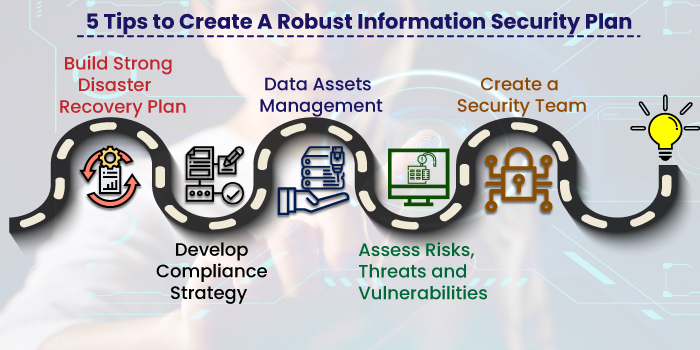Cybersecurity has become a constant concern in the digital world.
Cybersecurity threats and system vulnerabilities are advancing proportionally with the growth and evolution of technology.
All businesses, regardless of size, nature and industry, are facing a slew of new cybersecurity threats in the present data-driven world.
In fact, 61% of businesses experienced at least one cyberattack in 2019.
A successful cyberattack can inflict long-term damages on the business. It can also affect brand reputation as well as customer’s trust.
According to a recent Cybersecurity Ventures’ report, the damage related to cybercrime is projected to hit USD 6 billion annually by 2021.
So, the businesses must take pre-emptive steps in managing threats that may compromise their critical data.
There’s a need to acknowledge and create an Information Security Program Plan as the cornerstone for your company’s security foundation.
What is Information Security Program Plan?
An information security plan is a set of your company’s information security policies, regulations and standards. It outlines the organization’s sensitive information and the steps to be taken to secure that information.
The security program plan provides a strategic roadmap for effective security management practices and controls, analyses the risk associated with security breaches, and details the response in the event of a breach.
Moreover, it includes the identification and assignment of roles and responsibilities for different aspects of information security.
Importance of Information Security Program Plan

The information security risks have skyrocketed in recent times.
According to a recent report by Risk Based Security, data breaches exposed over 4.1 billion records in the first half of 2019.
More importantly, the data breaches can take a long time to be detected, thereby inflicting significant business damage before they are discovered.
The average time to identify a security breach in 2019 was seven months, and the average lifecycle of a breach lasted almost 11 months in 2019.
Owing to these festering trends, the organizations, irrespective of their business size, are striving to stretch to the max to forestall these breaches.
At this juncture, information security program development and management has emerged as the need of the hour helping businesses create a robust security landscape.
The security plan ensures the Integrity, Confidentiality, and Availability of critical information through effective security management.
In addition, a security plan enables you to channel your resources in strategic ways that would secure your data.
Also Read | 8 Cybersecurity Predictions for 2020 and Beyond
Fundamentals of Information Security Program Plan
Though cybersecurity trends are continually evolving, the basic principles of a robust security program always remain the same. Here is a list of fundamentals of any information security program:
1) Security Screening
Pre-employment screening helps the organization reduce drastically the security risks that are embedded in human interaction.
Screening employees and determining roles and responsibilities can go a long way in creating a secure workforce.
2) Organization-wide Security Policy
An organization-wide information security policy is the foundation of an information security program. It portrays the strategy of the organization for securing critical resources.
3) Identifying Assets
Identifying organizational assets and their values helps in determining what exactly is a security risk. Without knowing the assets, it would be difficult to determine the time and effort needed to be taken to secure these assets.
5 Tips to Create A Robust Information Security Plan

A good information security plan gives a comprehensive picture of how to secure critical resources and mitigates the risk of losing data in any way.
Here are a few steps to create a reliable information security plan:
1) Build Strong Disaster Recovery Plan
A Disaster Recovery Plan (DRP) is a documented, structured approach that organizations should follow when responding to disasters. It enables efficient recovery of critical systems and helps an organization avoid further damage to mission-critical operations during or after a disaster.
2) Develop Compliance Strategy
Businesses of all sizes are striving to maintain compliance with the increasing multitudes of regulations and compliance demands in the present day. The success of any compliance strategy depends on how well it is planned and implemented, and how well it responds to new rules.
So, it’s imperative to work out a compliance strategy that can be applied in an information security strategy.
Stay abreast of the new standards to avoid hefty fines from regulatory bodies.
3) Data Assets Management
Data assets are widely regarded as an imperative aspect of driving business value. Information, processed, or stored by the organization, has a measurable value that is integral to achieving strategic goals and gaining a competitive advantage.
Data assets management enables organizations to know what data assets they have and where they are located, ensuring that all data assets, hardware and software are tracked so they can be secured properly.
Managing data assets starts with documenting the hardware, applications, databases, and other information assets such as network shared folders and FTP sites. The assets are then prioritized based on the value of the information they contain.
4) Assess Risks, Threats and Vulnerabilities
The organization should list all the pertinent threats, applicable vulnerabilities and potential risks. Categorize and rank them based on their impact on the organization. Then, figure out the strategies and controls you need to adopt to secure your critical assets from these threats.
5) Create a Security Team
A skilled IT security team helps in reducing time to detect and time to resolve the cyber risks while mitigating the risks. Ensure to educate your team with the right skills to devise and implement a cybersecurity plan that truly addresses an ever-changing threat landscape and protects your critical assets.
The security team must be responsible for regular IT security operations such as managing IT assets and risks, assessing threats and vulnerabilities, establishing policies, developing procedures and controls, and conducting internal audits.
In Conclusion
Owing to the growing number of security threats, information security is no longer a concern of just the IT security department rather of an entire organization.
An effective information security program plan is an organization-wide effort to deal with IT security holistically.
Contact StealthLabs To Get Started!
Stealthlabs is a US-based information security solutions provider dedicated to helping organizations achieve a robust security posture. With more than a decade-old industry presence, we bring in advanced expertise in our cybersecurity advisory and consulting offerings.
Our portfolio of Information Security services includes Regulatory, Compliance and Advisory Services, Incident Management, Identity and Access Management, and Managed IT Security Services.
Recommended Stories:

